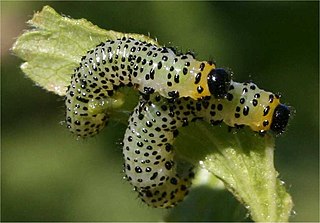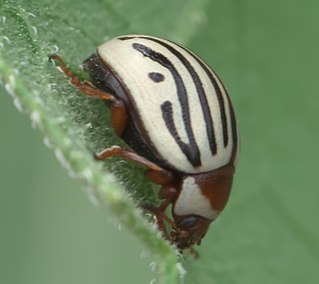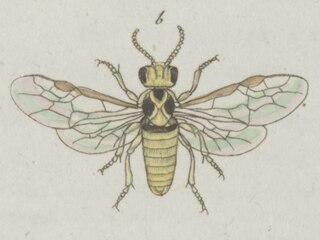
Sawflies are wasp-like insects that are in the suborder Symphyta within the order Hymenoptera, alongside ants, bees, and wasps. The common name comes from the saw-like appearance of the ovipositor, which the females use to cut into the plants where they lay their eggs. The name is associated especially with the Tenthredinoidea, by far the largest superfamily in the suborder, with about 7,000 known species; in the entire suborder, there are 8,000 described species in more than 800 genera. Symphyta is paraphyletic, consisting of several basal groups within the order Hymenoptera, each one rooted inside the previous group, ending with the Apocrita which are not sawflies.

Nematus ribesii is a species of sawfly in the family Tenthredinidae. English names include common gooseberry sawfly and imported currantworm. This insect is best known as a pest of gooseberries. The larvae feed on the foliage of the plant, often defoliating it completely.

Cydia nigricana, the pea moth, is a moth of the family Tortricidae. It is found in Europe.

Xanthogaleruca luteola, commonly known as the elm-leaf beetle, is a beetle species in the family Chrysomelidae that is native to Europe but invasive in other parts of the world.

Etiella behrii is a species of moth of the family Pyralidae, occurring sporadically but when present considered a serious pest of agricultural crops throughout parts of Australia.

Choreutis nemorana, the fig-tree skeletonizer moth or fig leaf roller, is a species of moth of the family Choreutidae.

The iris sawfly is a species of sawfly in the family Tenthredinidae. Native to Europe, the larvae—more often noticed than the adults—can occur in large numbers causing damage to garden plants such as the yellow iris or flag, Iris pseudacorus.

Nematus leucotrochus is a species of sawfly in the family Tenthredinidae, known as the pale-spotted gooseberry sawfly. Widespread throughout central and northern Europe, this insect is best known as a pest of gooseberries. The larvae feed on the foliage of the plant, defoliating it. Unlike Nematus ribesii, the common gooseberry sawfly, the species has a single brood. Adults appear in early May and larvae in May and June.

Nematus is a genus of sawfly in the family Tenthredinidae. Some of its species, including Nematus leucotrochus, Nematus olfaciens and Nematus ribesii, eat the leaves of fruit bushes and trees, and can be serious pests.

Calligrapha exclamationis, commonly known as the sunflower beetle, is a species of leaf beetle belonging to the family Chrysomelidae, in the subgenus Zygogramma, which was formerly a genus. It is regarded as a pest of sunflower crops in North America.
Thrips simplex is a species of insect in the genus Thrips in the order Thysanoptera. It is commonly known as the gladiolus thrips and infests gladiolus plants as well as various other monocotyledonous plants such as lilies, irises and freesias.
Tomostethus multicinctus, the brownheaded ash sawfly, is a species of sawfly in the family Tenthredinidae that is native to southern Canada and the eastern United States. Adults of this species resemble wasps and the larvae feed on the leaves of ash trees.
Hoplocampa testudinea, the apple sawfly or European apple sawfly, is a species of sawfly in the family Tenthredinidae. It is native to Europe but has been accidentally introduced into North America where it became invasive. The larvae feed inside the developing fruits of the apple tree.

Nematus oligospilus, commonly known as the willow sawfly, is a species of sawfly in the family Tenthredinidae. Native to central and northern Europe and Asia, it was first recorded in South America in the 1980s and New Zealand in 1997, and has also been introduced to Australia, South Africa and Lesotho. Its larvae feed on the leaves of various species of willow.

Diprion similis is a species of sawfly in the family Diprionidae. It is native to central and northern Europe and Asia but was accidentally introduced into North America where it has become invasive. The larvae feed on the needles of pine trees, especially those of the white pine. In North America it is known as the introduced pine sawfly or the imported pine sawfly. It is also known as the white pine sawfly because of its preference for feeding on the white pine, but this name is confusing because another sawfly, Neodiprion pinetum, whose larvae also feed on this tree, is itself known as the "white pine sawfly".

Eriocampa ovata, known generally as the alder sawfly or woolly alder sawfly, is a species of common sawfly in the family Tenthredinidae. The larvae feed on the leaves of the common alder and the grey alder, sometimes causing defoliation.
Cacopsylla pyricola, commonly known as the pear sucker, is a true bug in the family Psyllidae and is a pest of pear trees (Pyrus). It originated in Europe, was introduced to the United States in the early nineteenth century and spread across the country in the next century.

Profenusa thomsoni, the amber-marked birch leaf miner, is a species of sawfly in the family Tenthredinidae. It is native to the Palearctic realm but has spread to North America. The larvae feed on the foliage of birch trees.

Hoplocampa flava, commonly referred to as the "plum sawfly" is a species of Hoplocampa sawfly. It has been found near the Mediterranean basin, Western Europe, Estonia, Latvia, Lithuania, the Caucasus and from Eastern Russia to the Ural Mountains. It has been known to be locally common in these areas. It is a common pest of plum orchards.














